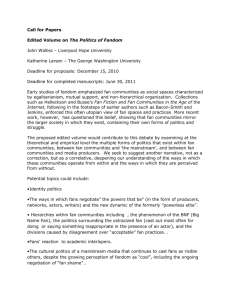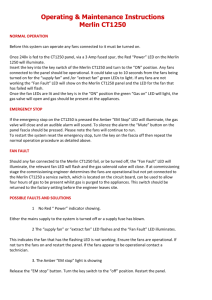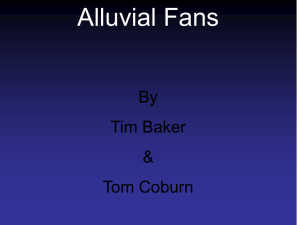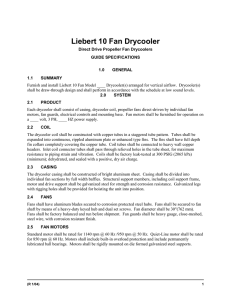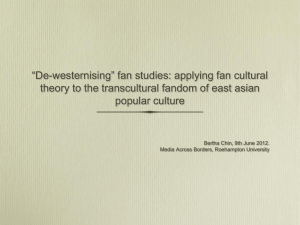Understanding Fandom
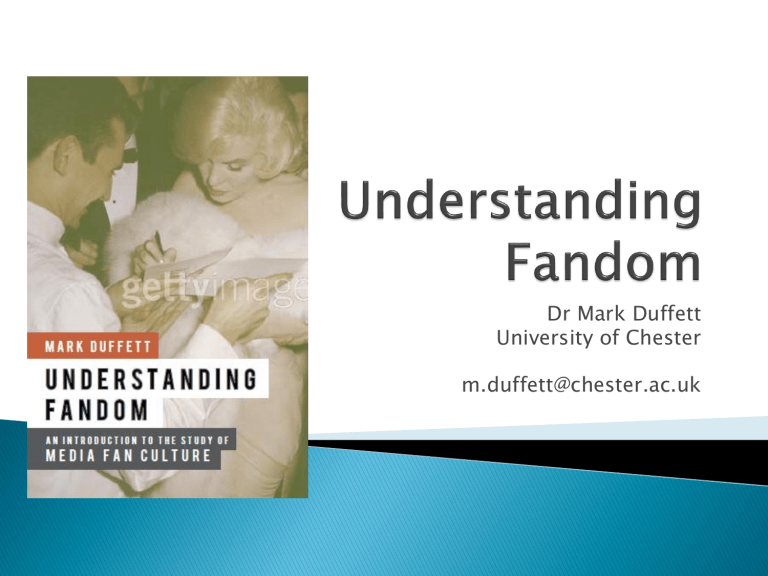
Dr Mark Duffett
University of Chester m.duffett@chester.ac.uk
What is a fan?
How should fandom be understood?
Fandom in an age of digital media
We must stop talking amongst ourselves.
We need to start listening to ‘the
fan’. (Michael Rapino, 2006)
Kim Jong-il was obsessed with Elvis
Presley. His mansion was crammed with his idol's records…He even copied the King's
Vegas-era look of giant shades, jumpsuits
and bouffant hairstyle. (Tom Newton Dunn,
2011)
Fans are NOT:
◦ Insane / diseased.
◦ Misguided religious zealots.
◦ Consumerists (or only consumers).
◦ Exclusive to one type of identification.
Fans ARE:
◦ A connected, dedicated and continually engaged fraction of the audience.
◦ Clearly identified to themselves (“I realized
I was a fan”).
◦ Often in fan clubs.
Fans ARE:
◦ Interested in various objects.
◦ Captivated by the pleasure they get from a performance.
◦ ‘In love’ = building a fan community.
Even if they go off you eventually, you’ll always stay in their hearts somewhere, because it’s almost as if we’ve been through something together that is unforgettable.
Music frees people and it unifies people and that’s what’s so incredible about it… Singing is – pow – the full explosion of emotion… Music is a very personal thing and it does free people, at least mentally. They hear music and believe that they are free and that anything is possible. Of course, it isn’t. That’s the power of music. (Morrissey, 2006)
THE KNOWING FIELD – Bert Helliger (2001):
Representatives are chosen for essential family members and are placed in physical relationships to one another... The representatives are not asked to “play a role” or to participate in a psychodrama... One of the phenomena that occurs is that the representatives begin to feel movements, feelings and reactions that seem foreign to their own personal lives.
Emile Durkheim’s sociology of religion - the mechanism of effervescence:
◦
WHOLE TRIBE >> TOTEM >> EACH WORSHIPPER
= a circuit of perceived energy.
◦
Sacred / profane replaced by the continuous pull of intimacy
“It’s a high that you just don’t get from anything else.”
- Tom Jones on live performance
This unusual surplus of forces is quite real: it comes to him from the very group he is addressing. The feelings provoked by his speech return to him inflated and amplified, reinforcing his own. The passionate energies he arouses echo back to him and increase his vitality. He is no longer a simple individual speaking, he is a group incarnate and personified.
Durkheim (1912)
It is like standing next to the tube
[train] coming in on the underground; it’s just this sheer energy that comes rumbling up.
- Cerys talking about Tom’s voice
Some consequences of effervescent attachments:
◦ Source of energy to get through hard times.
◦ Quest for intimacy with star (fan mail, etc).
◦ Interest in star’s biography and earlier performances.
◦ Practices that extend pleasures (collecting, etc).
◦ Expressions of fan creativity in relation to star’s world.
◦ New shared values (protecting star, representing fan base).
◦ Social organization (fan clubs, meet-ups, taste cultures).
To enter the knowing field:
◦ 1. You must know that the artist has convinced other people by his or her performance.
◦ 2. You must feel emotionally connected to the artist’s performance.
Once BOTH assumptions are met, the individual becomes fascinated.
If I actually name the day I became an Elvis fan, the moment I became an Elvis fan was at the Leicester convention... They played American Trilogy . Some guy grabbed my hand and pulled me up to my feet. I felt this adrenaline go through from the top of my head to the bottom of my feet and it was just an astonishing feeling of brotherhood, almost, in the room. Just this family, you were in amongst this family.
(in Duffett, 1998)
Hatsune Miku – virtual pop star:
Pre-digital model:
◦ Record companies decide what to promote.
◦ Broadcasting as gateway to mass exposure.
◦ Audiences pay directly for recordings.
◦ New fans seek out the grapevine.
◦ Fans promote artists by calling radio.
Digitial model (cult and new artists):
◦ Artists decide what to release.
◦ Broadcasting and Internet exposure.
◦ Free music as outreach / subscription.
◦ Grapevine of blogs and social media.
◦ Fans co-perform / participatory culture.

